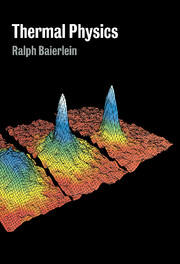Book contents
- Frontmatter
- Contents
- Preface
- 1 Background
- 2 The Second Law of Thermodynamics
- 3 Entropy and Efficiency
- 4 Entropy in Quantum Theory
- 5 The Canonical Probability Distribution
- 6 Photons and Phonons
- 7 The Chemical Potential
- 8 The Quantum Ideal Gas
- 9 Fermions and Bosons at Low Temperature
- 10 The Free Energies
- 11 Chemical Equilibrium
- 12 Phase Equilibrium
- 13 The Classical Limit
- 14 Approaching Zero
- 15 Transport Processes
- 16 Critical Phenomena
- Epilogue
- Appendix A Physical and Mathematical Data
- Appendix B Examples of Estimating Occupation Numbers
- Appendix C The Framework of Probability Theory
- Appendix D Qualitative Perspectives on the van der Waals Equation
- Index
16 - Critical Phenomena
Published online by Cambridge University Press: 05 June 2012
- Frontmatter
- Contents
- Preface
- 1 Background
- 2 The Second Law of Thermodynamics
- 3 Entropy and Efficiency
- 4 Entropy in Quantum Theory
- 5 The Canonical Probability Distribution
- 6 Photons and Phonons
- 7 The Chemical Potential
- 8 The Quantum Ideal Gas
- 9 Fermions and Bosons at Low Temperature
- 10 The Free Energies
- 11 Chemical Equilibrium
- 12 Phase Equilibrium
- 13 The Classical Limit
- 14 Approaching Zero
- 15 Transport Processes
- 16 Critical Phenomena
- Epilogue
- Appendix A Physical and Mathematical Data
- Appendix B Examples of Estimating Occupation Numbers
- Appendix C The Framework of Probability Theory
- Appendix D Qualitative Perspectives on the van der Waals Equation
- Index
Summary
Here, in brief outline, is the run of the chapter. Section 16.1 presents two experiments to introduce the topic of “critical phenomena,” as that phrase is used in physics. The next section illustrates the mathematical behavior of certain physical quantities near a critical point. Section 16.3 constructs a theoretical model: the Ising model. The following two sections develop methods for extracting predictions from the model. The last three sections draw distinctions, outline some general results, and collect the chapter's essentials.
Achieving a sound theoretical understanding of critical phenomena was the major triumph of thermal physics in the second half of the twentieth century. Thus the topic serves admirably as the culmination of the entire book.
Experiments
Liquid–vapor
We begin with an experiment that you may see as a lecture demonstration, performed either with carbon dioxide or with Freon, a liquid once used in refrigerators. A sealed vertical cylinder contains a carefully measured amount of CO2 (say) under high pressure. To begin with, the system is in thermal equilibrium at room temperature, as sketched in part (a) of figure 16.1. A distinct meniscus separates the clear liquid phase from the vapor phase above it.
Now heat the system with a hair dryer. The meniscus rises (because the liquid expands), and gentle boiling commences. Next the meniscus becomes diffuse, and then it disappears. The CO2 has become spatially homogeneous in density, as illustrated in figure 16.1 (b).
Information
- Type
- Chapter
- Information
- Thermal Physics , pp. 382 - 418Publisher: Cambridge University PressPrint publication year: 1999
